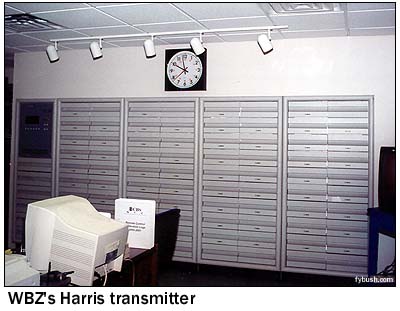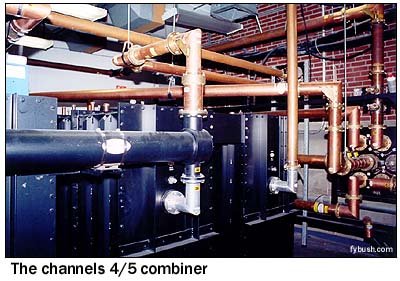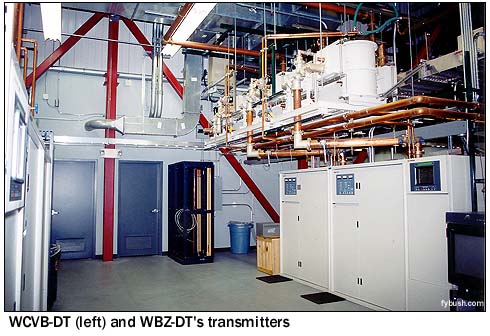
|
|
FYBUSH.COM/SITE OF THE WEEK
NEEDS YOUR SUPPORT! (AND YOU CAN GET A FREE TOWER SITE CALENDAR
IF YOU PLEDGE NOW...) CLICK HERE
TO LEARN MORE...
 July 23 - August 6, 2004
July 23 - August 6, 2004
WBZ-TV, et al, Needham, Mass.
One of the most inspiring drives in North America - at least for the inveterate tower hunter - is the segment of Route 128 (only the tourists and AASHTO call it "I-95") that runs along the Needham/Newton town line just south of the Mass Pike (only the tourists and AASHTO call it "I-90") and west of Boston.
Today, the tower-hunting driver will see four tall towers lining that stretch of highway. To the east are the self-supporting tower of WHDH-TV (Channel 7), the guyed tower that was once WHDH-TV (Channel 5) and is now the "FM-128" community tower site, and the candelabra tower that's home to WFXT (Channel 25), WSBK (Channel 38) and WLVI (Channel 56).
 And
to the west sits the most impressive of them all - the 1295-foot
guyed tower that belongs to WBZ-TV (Channel 4).
And
to the west sits the most impressive of them all - the 1295-foot
guyed tower that belongs to WBZ-TV (Channel 4).
This tower dates back to 1957, when it went up on Cedar Street in Needham to replace the original WBZ-TV tower behind the Soldiers Field Road studios. That tower was destroyed in 1954 by Hurricane Carol, and for several years WBZ-TV operated from a temporary site north of the city, behind Malden Hospital.
When this tower was erected, it was considerably shorter than it appears now, measuring in at about 1200 feet. Initially, WBZ-TV (and the revived WBZ-FM 106.7, a year or so later) was the only occupant, but that changed over the years. In 1972, when WHDH-TV lost its license for channel 5, the new licensee, Boston Broadcasters, was unsuccessful in buying the old WHDH-TV tower from the Herald Traveler. Desperate for a place to put its antenna, the new WCVB-TV signed a deal with WBZ to become a tenant on this Needham tower.
Around that same time, classical WCRB-FM (102.5 Waltham) moved here from its old perch atop one of the WCRB(AM) towers a few miles to the north in Waltham. And Westinghouse generously provided tower space for Boston's public broadcasters as well, moving WGBH-TV (Channel 2) here from its original home atop Great Blue Hill in Milton and, in 1967, allowing WGBX (Channel 44) to use this tower, too.
From the 1970s until just a few years ago, the tower was topped by the Channel 4 antenna, with panel antennas below it for channels 5, 2 and 44, then the FMs below that.

|

|

|

|
Each broadcaster at this site built its own transmitter building; WGBH's is the first one you see as you drive up the private road from Cedar Street (in fact, it's the only one easily visible from the security gate. Today, it sits partially empty, home only to the WGBH-TV (Channel 2) analog transmitter.
WBZ's building is actually the last one you come to on the road past the gate, after passing WCVB's (we didn't get inside that one on this trip.)
WBZ is powered by a Harris solid-state analog transmitter (one of the earliest generation of solid-state units, when the concept of hot-swappable amplification modules was still brand new), with a venerable RCA still in place as a backup. A small room attached to the back of the building once housed WBZ-FM (which left this site in 1981 when Westinghouse sold it; it's now WMJX and transmits from the Pru, as we saw two weeks ago) and is now home to the combiner (a Dielectric, I believe) that takes the WBZ-TV channel 4 and WCVB channel 5 signals and sends them up to the shared antenna.
 WGBH's
building is relatively empty these days; the space that once
housed big tube transmitters for both Channel 2 and Channel 44
now houses only a solid-state Harris transmitter for Channel
2 (you can see it in the background in this photo).
WGBH's
building is relatively empty these days; the space that once
housed big tube transmitters for both Channel 2 and Channel 44
now houses only a solid-state Harris transmitter for Channel
2 (you can see it in the background in this photo).
At left in this picture is some basic switching and character-generator gear that will allow WGBH and WGBX to stay on the air even in the event of a total loss of their Allston studios, as long as a PBS satellite signal can be downlinked. (If you ever see the PBS national feed on both 2 and 44, with a nonstop CG ID for both stations, this would be where it's coming from!)
So what's with all the open space here - and where did channel 44 go?
Therein lies a tale of DTV and some forward thinking on the part of Westinghouse (later CBS) in Boston, and in particular Bob Hess, longtime director of engineering for the WBZ stations, who recently relocated to KMAX in Sacramento. Realizing that DTV was on the way and that it would put quite a strain on the available space on the old 1200-foot tower, Bob undertook a remarkable task: replacing the top of the old tower, 229 feet of five-foot-face tower with 303 feet of seven-foot-face tower to the top of the 1957-vintage tower, all the while keeping the existing services on the air (except for WCRB, which moved across the highway to the FM-128 facility).
 Today,
the tower is topped by two stacked broadband UHF antennas. The
top one carries WBZ-DT (Channel 30), WCVB-DT (Channel 20), WGBX-DT
(Channel 43) and WSBK-DT (Channel 39); the bottom one handles
WGBH-DT (Channel 19) and WGBX (Channel 44).
Today,
the tower is topped by two stacked broadband UHF antennas. The
top one carries WBZ-DT (Channel 30), WCVB-DT (Channel 20), WGBX-DT
(Channel 43) and WSBK-DT (Channel 39); the bottom one handles
WGBH-DT (Channel 19) and WGBX (Channel 44).
(The filtering involved in combining adjacent channels 19/20 and 43/44 into a single antenna would have been too challenging, and in any event this setup provides some redundancy should one antenna fail. WSBK, now co-owned with WBZ by Viacom, maintains its analog facilities across Route 128 at the candelabra tower for the time being.)
Below that are two panel antennas, the upper one shared by channels 4 and 5 and the lower one used by channel 2.
All those new signals needed lots of space for transmitters, and Viacom's solution was to build a big (30,000 square feet, if memory serves) common facility to house them all, complete with high ceilings to accommodate all the filtering and combining that's needed in such a master-antenna setup. As you walk into the building, you see first the WCVB-DT Harris Sigma CD transmitter, then its identical twin just a few feet away for WBZ-DT. (The space at the right of the WBZ-DT transmitter is now occupied by a very early Sony HDTV monitor; eventually, a third power amplifier cabinet will go here to provide some redundancy to the operation.)

 Behind
the WBZ-DT transmitter are rows of transmitters for WGBX-TV (it
had to move from the Channel 2 building to the new building to
work properly into the combiner with the DTVs), WGBH-DT, WGBX-DT
and WSBK-DT, and there's still room for more stations - including,
if demand warrants, an FM master antenna setup.
Behind
the WBZ-DT transmitter are rows of transmitters for WGBX-TV (it
had to move from the Channel 2 building to the new building to
work properly into the combiner with the DTVs), WGBH-DT, WGBX-DT
and WSBK-DT, and there's still room for more stations - including,
if demand warrants, an FM master antenna setup.
And just outside the gate sits one final surprise: a trailer next to the big satellite dish outside the gate is home to the Boston uplink for the Cancom satellite system that serves cable companies across Canada. So when you're sitting in Nova Scotia watching network affiliates from Boston, they're coming through those racks you see at the left.
A few housekeeping notes before we finish up this week: due to our hectic summer travel schedule, we're "Tower Site of Every Other Week" for the next few weeks. We'll be back to weekly updates after Labor Day (and the exciting National Radio Club Convention, being held right here in western New York), and in the meantime you can catch up on past favorites by searching our Index page. If you want to see more pictures of this site, you're in luck - Garrett Wollman was along for this tour, and his page on the Boston Radio Archives has even more images than you see here. And if you haven't heard, we're in the midst of our Summer Pledge Drive here on fybush.com, and we could really use your help right now - visit NorthEast Radio Watch for all the details. See you in two weeks!
Huge thanks to Bob Yankowitz and the engineering staffs of WBZ/WSBK and WGBH/WGBX for their gracious hospitality during our visit!
Still haven't ordered? It's not too late - Tower Site Calendar 2004 is STILL AVAILABLE! If you haven't yet ordered, what are you waiting for? Click here for ordering information!
- Previous Site of the Week: Prudential Tower, Boston
- In Two Weeks: WPMZ/WHJY/WBRU and WRIB, Providence, R.I.
- Site of the Week INDEX!
- How can you help support Site of the Week? Click here!
- Submit your suggestions for a future Site of the Week!
